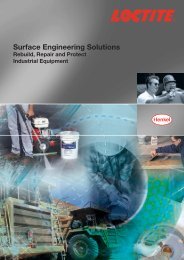Structural Bonding
Structural Bonding
Structural Bonding
Create successful ePaper yourself
Turn your PDF publications into a flip-book with our unique Google optimized e-Paper software.
94<br />
Retaining<br />
Choosing a retaining compound<br />
Retaining compounds are typically used to join nonthreaded<br />
cylindrical assemblies made of some sort of<br />
metal. Metals can be designated as active or inactive.<br />
Active metals (carbon steel, copper, or bronze) will<br />
typically corrode faster than inactive metals (stainless<br />
steel, plated parts, or anodized aluminum). When<br />
working with inactive metals, it is generally<br />
recommended that a primer be used to increase the<br />
cure speed of the retaining compound.<br />
New Loctite® retaining compounds have historically been<br />
formulated as liquids due to their reactivity to ensure<br />
they remain stable and ready to use. Recent<br />
breakthroughs have led to the development of a stable,<br />
semisolid stick formulation. This has opened the door to<br />
applications where the liquids were considered too messy<br />
or inconvenient. This new semisolid formulation allows<br />
direct contact of the compound to the part. This ensures<br />
not only that the product is placed exactly where it is<br />
needed, but also that it stays there as the cylindrical<br />
assembly is positioned and assembled.<br />
The following are key factors to consider when<br />
choosing a retaining compound.<br />
1. Gap Size Between Parts – Typically, low viscosity<br />
retaining compounds (125 to 2000 cps) are used for<br />
gaps up to 0.010". For gaps greater than 0.010",<br />
retaining compounds with higher viscosities<br />
(>2000 cps) should be used.<br />
2. Temperature Resistance – Most Loctite® retaining<br />
compounds are made to withstand temperatures<br />
up to 300°F. For those applications that require<br />
resistance greater than 300°F, Henkel offers a line<br />
of high temperature resistant Loctite® retaining<br />
compounds that can withstand temperatures<br />
up to 450°F.<br />
3. Bond Strength – In applications that require a<br />
permanent bond, a high strength retaining<br />
compound is recommended. If at some point in the<br />
future, parts will need to be taken apart for service, it<br />
is better to use a low or medium strength product.<br />
4. Cure Speed – Many production applications require<br />
retaining compounds with fast cure speed in order to<br />
maximize production rate. On the other hand, some<br />
applications require a slower cure so that adjustments<br />
can be made after the parts have been assembled. Our<br />
range of Loctite® retaining compounds offers varying<br />
rates of cure enabling you to choose the one that best<br />
matches your application.<br />
This chart should not be used to specify products without<br />
specific testing. It is recommended that you conduct on-part<br />
testing to ensure product performance before specifying any<br />
retaining compounds.<br />
Loctite® Adhesives and Sealants Product Specialists are available to<br />
assist you with new product designs, or to help you re- engineer an<br />
existing application for improved performance and cost savings.<br />
They can also set up testing of your parts at the Henkel Customer<br />
Engineering Center. For application assistance, call 1-800-LOCTITE<br />
(562- 8483) or visit www.loctite.com and select “Contact Loctite.” In<br />
Canada, please call 1-800-263-5043.



